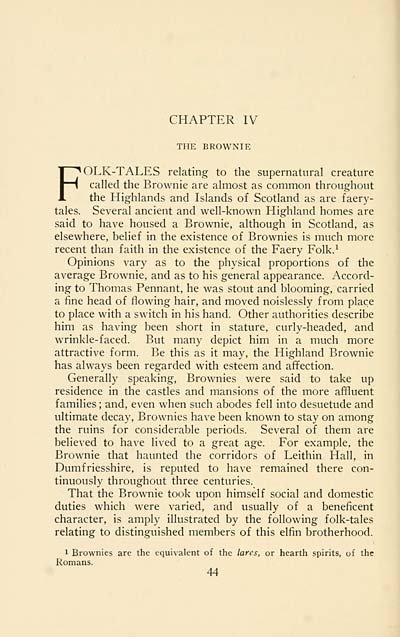Ossian Collection > Peat-fire flame
(74)
Download files
Complete book:
Individual page:
Thumbnail gallery: Grid view | List view

CHAPTER IV
THE BROWNIE
FOLK-TALES relating to the supernatural creature
called the Brownie are almost as common throughout
the Highlands and Islands of Scotland as are faery-
tales. Several ancient and well-known Highland homes are
said to have housed a Brownie, although in Scotland, as
elsewhere, belief in the existence of Brownies is much more
recent than faith in the existence of the Faery Folk.^
Opinions vary as to the physical proportions of the
average Brownie, and as to his general appearance. Accord-
ing to Thomas Pennant, he was stout and blooming, carried
a fine head of flowing hair, and moved noislessly from place
to place with a switch in his hand. Other authorities describe
him as having been short in stature, curly-headed, and
wrinkle-faced. But many depict him in a much more
attractive form. Be this as it may, the Highland Brownie
has always been regarded with esteem and affection.
Generally speaking, Brownies were said to take up
residence in the castles and mansions of the more affluent
families ; and, even when such abodes fell into desuetude and
ultimate decay. Brownies have been known to stay on among
the ruins for considerable periods. Several of them are
believed to have lived to a great age. For example, the
Brownie that haunted the corridors of Leithin Hall, in
Dumfriesshire, is reputed to have remained there con-
tinuously throughout three centuries.
That the Brownie took upon himself social and domestic
duties which were varied, and usually of a beneficent
character, is amply illustrated by the following folk-tales
relating to distinguished members of this elfin brotherhood.
1 Brownies are the equivalent of the lares, or hearth spirits, of the
Romans.
44
THE BROWNIE
FOLK-TALES relating to the supernatural creature
called the Brownie are almost as common throughout
the Highlands and Islands of Scotland as are faery-
tales. Several ancient and well-known Highland homes are
said to have housed a Brownie, although in Scotland, as
elsewhere, belief in the existence of Brownies is much more
recent than faith in the existence of the Faery Folk.^
Opinions vary as to the physical proportions of the
average Brownie, and as to his general appearance. Accord-
ing to Thomas Pennant, he was stout and blooming, carried
a fine head of flowing hair, and moved noislessly from place
to place with a switch in his hand. Other authorities describe
him as having been short in stature, curly-headed, and
wrinkle-faced. But many depict him in a much more
attractive form. Be this as it may, the Highland Brownie
has always been regarded with esteem and affection.
Generally speaking, Brownies were said to take up
residence in the castles and mansions of the more affluent
families ; and, even when such abodes fell into desuetude and
ultimate decay. Brownies have been known to stay on among
the ruins for considerable periods. Several of them are
believed to have lived to a great age. For example, the
Brownie that haunted the corridors of Leithin Hall, in
Dumfriesshire, is reputed to have remained there con-
tinuously throughout three centuries.
That the Brownie took upon himself social and domestic
duties which were varied, and usually of a beneficent
character, is amply illustrated by the following folk-tales
relating to distinguished members of this elfin brotherhood.
1 Brownies are the equivalent of the lares, or hearth spirits, of the
Romans.
44
Set display mode to: Large image | Transcription
Images and transcriptions on this page, including medium image downloads, may be used under the Creative Commons Attribution 4.0 International Licence unless otherwise stated. ![]()
| Early Gaelic Book Collections > Ossian Collection > Peat-fire flame > (74) |
|---|
| Permanent URL | https://digital.nls.uk/81146947 |
|---|
| Description | Selected books from the Ossian Collection of 327 volumes, originally assembled by J. Norman Methven of Perth. Different editions and translations of James MacPherson's epic poem 'Ossian', some with a map of the 'Kingdom of Connor'. Also secondary material relating to Ossianic poetry and the Ossian controversy. |
|---|
| Description | Selected items from five 'Special and Named Printed Collections'. Includes books in Gaelic and other Celtic languages, works about the Gaels, their languages, literature, culture and history. |
|---|

